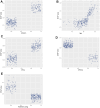Explainable machine learning in outcome prediction of high-grade aneurysmal subarachnoid hemorrhage
- PMID: 38431285
- PMCID: PMC10968679
- DOI: 10.18632/aging.205621
Explainable machine learning in outcome prediction of high-grade aneurysmal subarachnoid hemorrhage
Abstract
Objective: Accurate prognostic prediction in patients with high-grade aneruysmal subarachnoid hemorrhage (aSAH) is essential for personalized treatment. In this study, we developed an interpretable prognostic machine learning model for high-grade aSAH patients using SHapley Additive exPlanations (SHAP).
Methods: A prospective registry cohort of high-grade aSAH patients was collected in one single-center hospital. The endpoint in our study is a 12-month follow-up outcome. The dataset was divided into training and validation sets in a 7:3 ratio. Machine learning algorithms, including Logistic regression model (LR), support vector machine (SVM), random forest (RF), and extreme gradient boosting (XGBoost), were employed to develop a prognostic prediction model for high-grade aSAH. The optimal model was selected for SHAP analysis.
Results: Among the 421 patients, 204 (48.5%) exhibited poor prognosis. The RF model demonstrated superior performance compared to LR (AUC = 0.850, 95% CI: 0.783-0.918), SVM (AUC = 0.862, 95% CI: 0.799-0.926), and XGBoost (AUC = 0.850, 95% CI: 0.783-0.917) with an AUC of 0.867 (95% CI: 0.806-0 .929). Primary prognostic features identified through SHAP analysis included higher World Federation of Neurosurgical Societies (WFNS) grade, higher modified Fisher score (mFS) and advanced age, were found to be associated with 12-month unfavorable outcome, while the treatment of coiling embolization for aSAH drove the prediction towards favorable prognosis. Additionally, the SHAP force plot visualized individual prognosis predictions.
Conclusions: This study demonstrated the potential of machine learning techniques in prognostic prediction for high-grade aSAH patients. The features identified through SHAP analysis enhance model interpretability and provide guidance for clinical decision-making.
Keywords: SHapley additive exPlanations; aneurysmal subarachnoid hemorrhage; explainable machine learning; high-grade; prognosis prediction.
Conflict of interest statement
Figures






Similar articles
-
Accurately predicting the risk of unfavorable outcomes after endovascular coil therapy in patients with aneurysmal subarachnoid hemorrhage: an interpretable machine learning model.Neurol Sci. 2024 Feb;45(2):679-691. doi: 10.1007/s10072-023-07003-4. Epub 2023 Aug 25. Neurol Sci. 2024. PMID: 37624541
-
Predicting Long-Term Outcomes After Poor-Grade Aneurysmal Subarachnoid Hemorrhage Using Decision Tree Modeling.Neurosurgery. 2020 Sep 1;87(3):523-529. doi: 10.1093/neuros/nyaa052. Neurosurgery. 2020. PMID: 32171016
-
Preoperative and postoperative predictors of long-term outcome after endovascular treatment of poor-grade aneurysmal subarachnoid hemorrhage.J Neurosurg. 2017 Jun;126(6):1764-1771. doi: 10.3171/2016.4.JNS152587. Epub 2016 Jul 1. J Neurosurg. 2017. PMID: 27367238
-
Practical guide to SHAP analysis: Explaining supervised machine learning model predictions in drug development.Clin Transl Sci. 2024 Nov;17(11):e70056. doi: 10.1111/cts.70056. Clin Transl Sci. 2024. PMID: 39463176 Free PMC article. Review.
-
Survival prediction of glioblastoma patients-are we there yet? A systematic review of prognostic modeling for glioblastoma and its clinical potential.Neurosurg Rev. 2021 Aug;44(4):2047-2057. doi: 10.1007/s10143-020-01430-z. Epub 2020 Nov 6. Neurosurg Rev. 2021. PMID: 33156423 Free PMC article.
Cited by
-
Development and validation of nomograms for aneurysm rupture risk and prognosis in Moyamoya disease with intracranial aneurysms.Sci Rep. 2025 Jul 17;15(1):25987. doi: 10.1038/s41598-025-97255-1. Sci Rep. 2025. PMID: 40676132 Free PMC article.
-
Using Life's Essential 8 and heavy metal exposure to determine infertility risk in American women: a machine learning prediction model based on the SHAP method.Front Endocrinol (Lausanne). 2025 Jul 4;16:1586828. doi: 10.3389/fendo.2025.1586828. eCollection 2025. Front Endocrinol (Lausanne). 2025. PMID: 40687585 Free PMC article.
-
Development and Validation of Machine Learning Models for Outcome Prediction in Patients with Poor-Grade Aneurysmal Subarachnoid Hemorrhage Following Endovascular Treatment.Ther Clin Risk Manag. 2025 Mar 7;21:293-307. doi: 10.2147/TCRM.S504745. eCollection 2025. Ther Clin Risk Manag. 2025. PMID: 40071129 Free PMC article.
-
Lack of association between chronological age and fisher group and poor outcomes in older patients with severe-grade aneurysmal subarachnoid hemorrhage: a nationwide registry study in Japan.Neurosurg Rev. 2025 May 30;48(1):466. doi: 10.1007/s10143-025-03638-3. Neurosurg Rev. 2025. PMID: 40445438
-
Predicting Mortality in Subarachnoid Hemorrhage Patients Using Big Data and Machine Learning: A Nationwide Study in Türkiye.J Clin Med. 2025 Feb 10;14(4):1144. doi: 10.3390/jcm14041144. J Clin Med. 2025. PMID: 40004675 Free PMC article.
References
-
- Hu P, Liu Y, Li Y, Guo G, Su Z, Gao X, Chen J, Qi Y, Xu Y, Yan T, Ye L, Sun Q, Deng G, et al.. A Comparison of LASSO Regression and Tree-Based Models for Delayed Cerebral Ischemia in Elderly Patients With Subarachnoid Hemorrhage. Front Neurol. 2022; 13:791547. 10.3389/fneur.2022.791547 - DOI - PMC - PubMed
Publication types
MeSH terms
LinkOut - more resources
Full Text Sources

